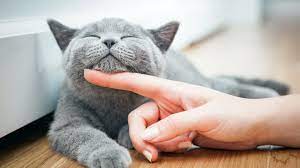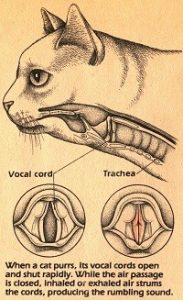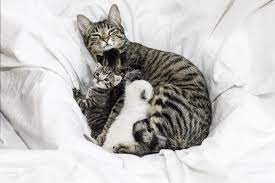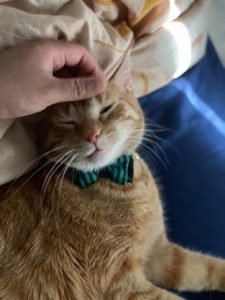
With Spring coming to an end and Summer is on its way, your cat will soon have a reason to purr! National Hug Your Cat Day is approaching and we are ready for it. Not every cat enjoys being hugged, but that doesn’t mean you can’t love on your precious feline friend a little more than usual on this day. But how do you know if your cat is feeling happy? Let’s take a deep dive into one of the most recognizable signs of happiness in cats: that signature purr.
How do they do it?

Cats have a special connection that involves their brain, larynx and diaphragm. When the cat’s brain fires that connection, it signals nerves to the larynx and diaphragm to oscillate causing tension on the glottis which contains the vocal cords. This rapid vibration creates a valve for air to pass through. As your cat breathes in and out, the valve opens and closes rapidly, resulting in the purr.
Why do they do it?
We as pet parents associate purrs with a cat being in a relaxed environment sending out waves of calmness. They may also purr when you stroke them exhibiting happiness. However, they purr to communicate other emotions and needs too.

– Purring is a complex process that benefits both the cat and those around her. A kitten’s natural instinct to purr starts from as early as two days old and is vital to their survival. Mama cats use purring vibrations to guide kittens to their warmth and comfort, while kittens purr to communicate and bond with their mothers and littermates. Purring, instead of using other louder vocalizations, makes it more difficult for predators to locate recent moms and kittens in the wild.
– The behavior exhibited by kittens at an early age to get the attention of their mom can oftentimes continue into adulthood. Cats express hunger and the need to be fed by way of purring accompanied by a high frequency cry harder to ignore.

– Plus, the low frequency vibrations of a purr are known to heal bones and relieve pain in muscles, tendons, ligaments and joints. Thanks in part to the healing properties of this specific vocalization, cats seem to rebound more quickly from injuries than other animals and experience fewer complications during surgeries.
– In fearful or stressful situations, like arriving in a new home or being placed in a carrier to visit the veterinarian, cats purr as a comfort mechanism.
– And research shows that the low frequency of purrs benefits humans as well by bringing on relaxation, helps relieve anxiety, and decreases high blood pressure.

So how can you tell the difference?
To better understand why your cat is purring, look at their body language and behavior. If they are kneading with their paws, butting their head, or rubbing up against you, they are probably happy and content. However, If they are crouched low to the ground and look at you with dilated pupils, they are likely afraid or anxious. If your cat looks lethargic or shows symptoms of malaise, contact your veterinarian immediately.
Purring is a strange and magical occurrence. This vibration is just one way cats communicate and it is important to observe the differences between the sound and frequency of each instance to be able to tell if your cat needs medical attention or is truly happy and relaxed in their environment. So this Hug Your Cat Day, take a moment to give your feline friend some extra love and a positive reason to let out some purrs!





Leave a Reply